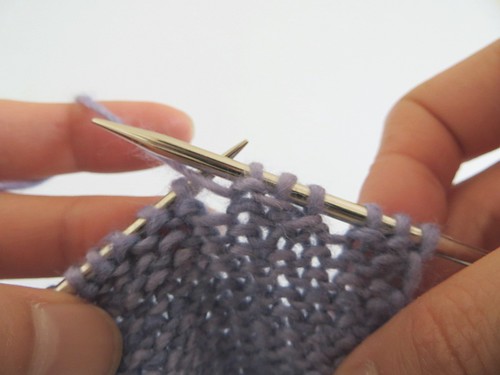As promised in the second to last post, here's a tutorial of a new? short rows technique - mix of W&T and Japanese method.
On RS, as with W&T method, you knit to the turn-back point, slip one stitch, and bring your working yarn in front. I usually replace wrapped st on LN before turning work so as not to lose it.
Turn work and bring back working yarn in front (WS of work now). And - it's the crucial point - slip the first st with yarn in front (photo), instead of purling it.
On the photo, I purled the second st.
And you resolve the gap as W&T method: on RS, you work to wrapped st (photo) and lifting wrap with RN tip, knit together with the st.
Here's the result from WS. Wrap is longer with this technique; yarn goes across slipped sts.
On WS, you proceed as on RS.
You purl to the turn-back point, slip one stitch on RN and bring your working yarn in back. Replace the st on LN, turn work, bring the yarn in back.
And slip the first st wyib (photo).
Here, I knitted the second st.
To resolve the gap, when you come back to wrapped st (photo), lift the wrap onto LN inserting RN tip into wrap from the bottom in back.
Purl the wrap and the st together. That's what you do with W&T!
The result from WS.
And what is striking is that you obtain the same result as Japanese method 2 (slipped st and yo). This is indeed totally logical because, instead of keeping turn loops on the needle with yo, we wrap it around sts. The result on RS is just as neat and what's more, you don't need to reverse YO and st to purl on WS :) Not bad, is it? We can call this way Japanese Wrap & Turn!
To be honnest, I have to add that this result on RS is the same as German short rows technique (or double st) - and conncecting loop on WS is nonexistent with German method, which provides even neater fabric.
But if you're used to W&T, this Japanese W&T is a good compromise!









No comments:
Post a Comment